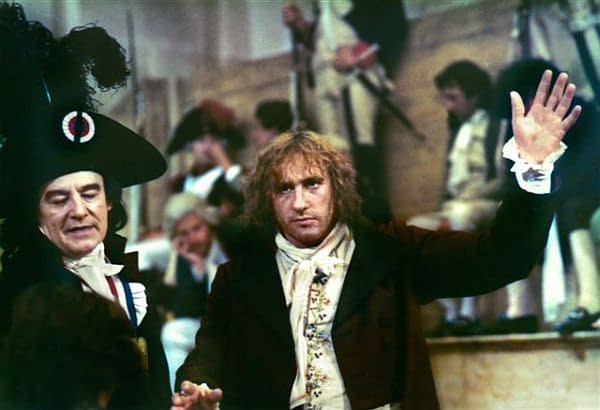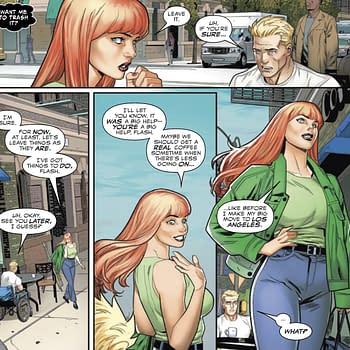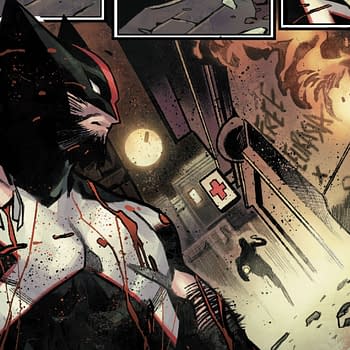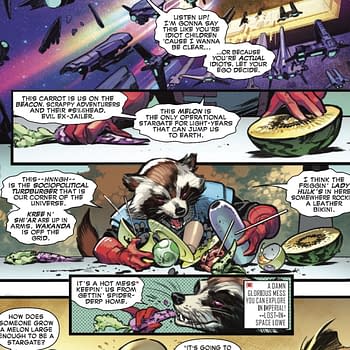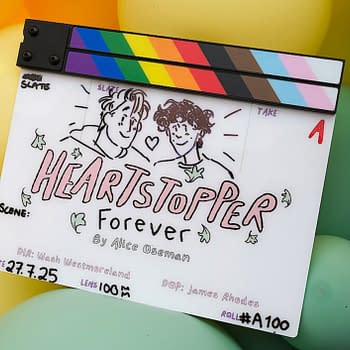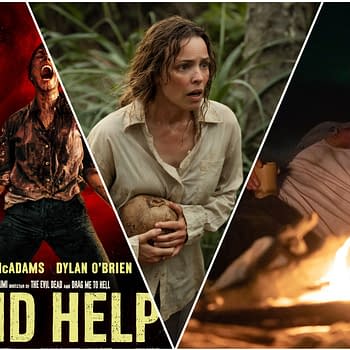Posted in: Movies | Tagged: Batman, Comics, dark knight, dc, denver, rises
Look! It Moves! by Adi Tantimedh: The Dark Knight Flashpoint
So THE DARK KNIGHT RISES has become a kind of flashpoint for cultural preoccupations and anxieties on levels both surprising and unexpected tragic. It's one of those pop culture artifacts that has attuned itself so sharply to the ether that it becomes a magnet for unforeseen occurrences that puts it even more firmly into the time it was made in. It's fascinating that where people used to see Batman as a kitsch figure of fun, Christopher Nolan has transformed him into an embodiment of the American zeitgeist and all its contradictions and confusions in a way no other character, not even Superman, could.
I can't help feeling that with THE DARK KNIGHT RISES, Hollywood movies are finally dancing with the apocalypse the same way Japanese pop culture has been for decades. Coincidentally, DARK KNIGHT RISES shares some themes with John Wagner's apparently final JUDGE DREDD storyline in 2000AD that just ended a few weeks ago, DAY OF CHAOS, where Judge Dredd saw Mega City One face near-annihilation with over three quarters of its population – and the Judges – wiped out in all-out civil war because of propaganda and other chaotic conflagrations, dealing with the conflict between Order and Chaos, and with a far less comforting conclusion than the one Batman arrives at. It should be noted that John Wagner is pretty much an anarchist writing a dark satire where fascism is the best answer against all-out apocalyptic chaos. It's all in the air these days.
But back to Batman.
The thing is, Batman has been a flashpoint for American cultural mores since Frank Miller's THE DARK KNIGHT RETURNS was published in 1986 when Miller's dark, adult approach to the character featured shooting-in-all-directions satires on the Reagan era, complacent hippies, political correctness and its tension with the fascistic aspects of Batman and the superhero genre paved the way for not only subsequent portrayals of Batman in comics and movies, but Christopher Nolan's trilogy as well. You could argue that Superman and Batman comics in the 1960s and 1970s reflected unconsciously the trends and anxieties of the day as well, but not intentionally. It was the 1980s that this approach to storytelling became more overt. The Tim Burton movies and Joel Schumacher's decadent campy fiasco were expressions of 80s and 90s decadence, especially the lack of coherent narratives, but Nolan's trilogy took Batman to a more somber, adult allegorical space.
I think it's too much to ask of a blockbuster comic book movie to provide us with any answers, but what fiction does best is reflect current anxieties and societal obsessions, and Christopher Nolan has used Batman to make a trilogy of allegorical post-9/11 American anxiety the same way that Eastern Bloc movies used symbolism and allegory to comment on life under Soviet rule in order to avoid censorship, only in Nolan's case, he didn't have to worry about censorship. If anything, where every other movie that tried to tackle 9/11 and the War on Terror directly in the past decade has failed either artistically or financially or both, Nolan's Batman trilogy have been huge hits. It seems that tackling the issues and themes allegorically and symbolically has made them palatable to audiences seeking entertainment and escapist solace. This is interesting considering how somber and downbeat much of the trilogy is. Nolan has pretty much subverted the usual triumphalist power fantasies of the superhero genre and turned the Batman movies into something darker, more somber and ambivalent. THE DARK KNIGHT RISES actually contains some fairly complex questions about the purpose of popular myth and propaganda, including untrue ones, to ensure social order and cohesion in ways that political philosopher Leo Strauss used to write about. That's pretty heady for a comic book movie.
Nolan has said that he and his co-writers didn't use the Occupy Movement as inspiration but Charles Dickens' A TALE OF TWO CITIES, which was set in the French Revolution and detailed the descent of a society into chaos once a fanatical revolutionary order took over. The scenes of the show trials in THE DARK KNIGHT RISES were designed to recall the show trials as depicted in tales from the French Revolution, and Bane is not an avatar of the Right or the Left so much as Robespierre. I was reminded of Andrzej Wajda's 1983 movie DANTON, which was set in the time of the Terrors in the French Revolution and could itself be seen as a veiled allegory of Poland under the Communist regime at the time. Of course, Bane's fanatical nihilism is a kind of straw man you only find in comic book stories, the kind of pretender to revolution who's really out to destroy everything that exists mainly in reactionary minds (there's no proof that the Occupy Movement was about nihilism at all except in the minds of the Right, considering the Occupiers were only demanding accountability in the banking system) but serves the purposes of unsubtle pulp entertainment. Typically, the movie doesn't really have any faith or belief in the collective action of people. It talks about the haves and have-nots but doesn't really show ordinary people or their reactions. Nolan's Bruce Wayne is more a rich anarchist who doesn't even seem to care much about holding onto his money, and whose tactics are often fascistic.
The trilogy really works best when read as allegories and symbols. When Ra's al-Ghul compared Gotham City as a modern Sodom and Gommorah whose destruction would cause the other cities in the world to follow in BATMAN BEGINS, it only made sense if you read Nolan's Gotham as an allegory for America. American critics immediately seized upon BATMAN BEGINS' reflection of post-9/11 America and the threats of terrorist destruction. THE DARK KNIGHT took the allegory even further with the battle between Batman and the Joker as a conflict between Chaotic Good and Chaotic Evil. THE DARK KNIGHT RISES continues the series' dance with the hot button themes of fascism, terrorism, social collapse and chaos without overtly taking a side on right or left, which leaves plenty of room for pundits on both the left and right to try to claim it for themselves, just as with THE DARK KNIGHT a few years back. Neither side has acknowledged that Batman's actions in the movies have made him more of an ambivalent anarchist than a conservative. As a vigilante, he's breaking the law while trying to enforce justice, and his use of might and illegal surveillance tend to flirt with fascism, making him a mass of contradictions neither left nor right. And Nolan also made it a point to have Batman's fall from grace turn him into an underdog instead of the one with power to put us on his side.
Topographically, Nolan's Gotham has always been a mish-mash of several cities edited together. In BATMAN BEGINS, it was a combination of Chicago and London's Canary Wharf. In THE DARK KNIGHT, it was mostly Chicago, alluding to that city's status as the preeminent city for ruthless American politics, and in THE DARK KNIGHT RISES, it's made up of parts of Downtown Los Angeles, Newark, Pittsburgh and very recognisable parts of New York City, from the skyline to the scenes of urban clashes in the Financial District. New York being the financial capital ends up referencing the economic meltdown and Occupy Wall Street, even though the script was written back in 2008, well before the emergence of the Occupy movement. In that respect, Gotham becomes not just every city in America but a symbol of America itself, which serves Nolan's purpose when Bane takes over the city and subjects it to a nihilistic rule of terror while pretending to be a leftist liberator. Catwoman here is a mouthpiece for class resentment and social inequality. If the movie settles on any stance by the end, it's one of reconciliation.
And then you can't ignore the implications of the shooting in Colorado. Beyond the fact that crazy people will always gravitate towards popular events, especially when they want to kill as many people as possible, there's really nothing else to say, except that this has put the movie in an unfortunate, unexpected and horrible position of being part of the zeitgeist yet again. As Heath Ledger's death at the time of THE DARK KNIGHT's release connected it with drug and pill problems, now the Aurora shooting at a cinema has also placed it in the forefront of America's problem with guns and violence, neither case was part of the movies' stories or intended themes.
It's a strange and surreal twist that all roads lead to Batman.
If you're in the USA, you can watch DANTON on hulu.com
Leaping tall metaphors with a single bound at lookitmoves@gmail.com
Follow the official LOOK! IT MOVES! twitter feed at http://twitter.com/lookitmoves for thoughts and snark on media and pop culture, stuff for future columns and stuff I may never spend a whole column writing about.
Look! It Moves! © Adisakdi Tantimedh




